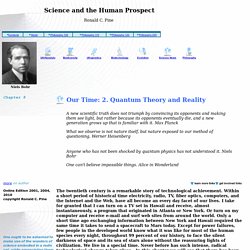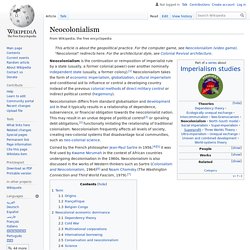

Saatchiart. Belief, Bodies, and Being: Feminist Reflections on Embodiment - Deborah Orr. Amazon.com. Chapter 1:Science and the Human Prospect. Mysticism and the Convergence Thesis One more interpretation of the implications quantum physics deserves some comment.

It is a very controversial interpretation because it claims that the results of modern science have validated a particular religious orientation. Neocolonialism. Proposed dominance of countries through culture and/or economics Neocolonialism, neo-colonialism, or neo-imperialism is the practice of using capitalism, globalization and cultural imperialism to influence a developing country in lieu of direct military control (imperialism) or indirect political control (hegemony).

Coined by the French philosopher Jean-Paul Sartre in 1956[1][2], it was first used by Kwame Nkrumah in the context of African countries undergoing decolonization in the 1960s. Deep Creek Conservation Park. IntroductionDeep Creek Conservation Park is located 13 km east of Cape Jervis on the south coast of the Fleurieu Peninsula, South Australia.

Approximately 1 1/2 hours drive from Adelaide, 45 minutes from Victor Harbor and 30 minutes from Yankalilla and Normanville, visitors can enjoy the natural and rugged remoteness of this park close to these major service centres. Aaron Creek Covering some 4,500 ha, Deep Creek Conservation Park is the largest remaining block of wildlife habitat on the Fleurieu Peninsula. The park contains a variety of landform and vegetation types and is home to a suite of native fauna.
The park is an important refuge for several species of conservation importance. Opening speech: ‘John Cato Retrospective’ and book launch at the Ballarat International Foto Biennale by Dr Marcus Bunyan. Opening: 17th August 2013 Exhibition dates: 17th August – 15th September 2013 It was an emotional time on Saturday afternoon as I opened the John Cato Retrospective.

I hope I did John and Dawn, their family and everyone proud. I burst into tears after the speech… I got a lovely email from Senga Peckham today which was very much appreciated: . Thank you so much for your excellent speech on Saturday. Text: ‘Un/settling Aboriginality’ Dr Marcus Bunyan / Exhibition: ‘Brook Andrew: 52 Portraits’ at Tolarno Gallery, Melbourne. Review: ‘Stormy Weather: Contemporary Landscape Photography’ at NGV Australia, Melbourne. Some Consequences of Four Incapacities. The Subject. Charles Sanders Peirce: The Subject as Semiosis by Andy Blunden 2005:6. Meaning of land to Aboriginal people - Creative Spirits. What does land mean to Aboriginal people?

Non-Indigenous people and land owners might consider land as something they own, a commodity to be bought and sold, an asset to make profit from, but also a means to make a living off it or simply 'home' . They 'develop' land, as if it was unfinished or raw. For Aboriginal people the relationship is much deeper. Palyku woman Ambelin Kwaymullina explains: "For Aboriginal peoples, country is much more than a place. They have a profound spiritual connection to land.
The health of land and water is central to their culture. Key take-away: The land owns Aboriginal people and every aspect of their lives is connected to it. Living in a city has its own challenges. The Land Owns Us. C. S. Pierce and the Nested Continua Model of Religious Interpretation - Gary Slater. Philosophy and Anthropology: Border Crossing and Transformations. The Sublime and the Spiritual. Through exploration of gesture, line, shape, and color, many Abstract Expressionist artists hoped to evoke strong emotional reactions.

Their grand scale created an overwhelming and, for some, almost religious viewing experience. Mark Rothko famously said that his paintings should be viewed from a distance of 18 inches, perhaps to dominate the viewer’s field of vision and thus create a feeling of contemplation and transcendence. Barnett Newman. Vir Heroicus Sublimis. 1950–51 Mark Rothko. Louise Nevelson. Julian Bell, 'Contemporary Art and the Sublime' (The Art of the Sublime) Philip Shaw, 'Modernism and the Sublime' (The Art of the Sublime) Towards the abject In 1900, in The Interpretation of Dreams, Freud presented a case study in the relations between the world, the flesh and the Symbolic.

As with many of the examples discussed in this essay, Freud framed his analysis in terms of a sublime encounter with female sexuality. A few years earlier he had treated a friend of the family, a young woman known as Irma, suffering from hysteria. He notes that this treatment had only limited success and that the patient was not relieved of her symptoms. Alison Smith, 'The Sublime in Crisis: Landscape Painting after Turner' (The Art of the Sublime) Pre-Raphaelitism and the anti-sublime Ruskin’s oscillating views on the sublime offer one important route into our exploration of how the topic was expressed in visual terms in the latter half of the nineteenth century, particularly in helping us to understand the difficulties artists had in articulating and expanding the Romantic sublime as it had developed up to the time of Turner.11 According to the scholar Morton Paley, the apocalyptic sublime was a mode that flourished during a period of domestic unrest and foreign wars.

It was a means of displacing into art the political and social dislocations produced by the turbulence of that era, as well as expressing the fervent religious evangelical belief that came to be challenged later in the century.12 However, apocalyptic imagery continued to dominate throughout the Victorian period, in dioramas and panoramas and in what have been regarded as the populist landscapes of John Martin. J.M.W. Turner Rain, Steam and Speed 1844 Fig.2. LECTURE #11: GEOFFREY BATCHEN – “IN ABSENTIA: THE POLITICS OF CAMERALESS PHOTOGRAPHY” – jamie williamson. The final talk of 2015 Public Lecture series was given by Geoffrey Batchen.

The Henry D. Thoreau Quotation Page: Wildness. In Wildness is the preservation of the World.

. — "Walking" I wish to speak a word for Nature, for absolute Freedom and Wildness, as contrasted with a Freedom and Culture merely civil, — to regard man as an inhabitant, or a part and parcel of Nature, rather than a member of society. . — "Walking" I long for wildness, a nature which I cannot put my foot through, woods where the wood thrush forever sings, where the hours are early morning ones, and there is dew on the grass, and the day is forever unproved, where I might have a fertile unknown for a soil about me As I came home through the woods with my string of fish, trailing my pole, it being now quite dark, I caught a glimpse of a woodchuck stealing across my path, and felt a strange thrill of savage delight, and was strongly tempted to seize and devour him raw; not that I was hungry then, except for that wildness which he represented What we call wildness is a civilization other than our own.
Art as representation. Art generally represents some aspect or aspects of the world, but what aspects, and to what extent? Modernism promoted originality, and Postmodernism renounces mimesis altogether. Read this section to appreciate the part played by medium or genre, the issues originally outlined by the Greeks, and the difference between illustrating concepts and embodying them. Introduction Whatever else it may do, art must represent something of the outside world. Summary and Analysis. Landscape after land rights, after conceptual art. Marshpdf. Andy grundbergthe crisis of the real. (14) "Photography as Performative Process" LevinPerformativeForceOfPhoto2009. Grundberg crisis 1. Review: Pilger's Utopia shows us Aboriginal Australia in 2014. Welcome to Aboriginal Australia in the 21st Century – John Pilger’s Utopia.
It was more than two decades ago when I saw John Pilger’s 1986 documentary The Secret Country for the first time. I was a 17-year-old Aboriginal male suffering the indignity of public housing Australia. My identity came with a sense of collective oppression that turned my indignity into both resistance and motivation. Such feelings of resistance became an empowering experience that lead to a pursuit of justice identified through education. Now, almost 30 years later, I find myself part of the middle class.
I have John Pilger and his latest documentary Utopia, which premieres in Australia today, to remind me that it hasn’t. Back to Utopia Pilger first visited the Aboriginal community of Utopia in Central Australia 28 years ago during the making of The Secret Country. He returned in 2013 to film Utopia to find things hadn’t improved. Somewhere else It’s that “somewhere else” that sparked my interest in this film. Pilger's cheap shots won't ease Indigenous oppression. Utopia (M). Director: John Pilger. 110 minutes Who is John Pilger talking to? Australia's boom is anything but for its Aboriginal people.
Eleven miles by ferry from Perth is Western Australia's "premier tourist destination". This is Rottnest Island, whose scabrous wild beauty and isolation evoked, for me, Robben Island in South Africa. Empires are never short of devil's islands; what makes Rottnest different – indeed, what makes Australia different – is silence and denial on an epic scale. "Five awesome reasons to visit! " John Pilger's damning new film about indigenous Australia. "It's so degrading," says Noongar elder Noel Nannup in John Pilger's latest film about indigenous disadvantage in Australia. Landscape photography Wikipedia, the free encyclopedia. Landscape Wikipedia, the free encyclopedia. Foundations of regional Australia FINAL. Definition of Landscape by Merriam Webster.
Regional Australia Wikipedia, the free encyclopedia.
NGV Collection. Ocean Flowers: Anna Atkins's Cyanotypes of British Algae. Collection History. DEEP BLUE HOME: ANNA ATKINS' OCEAN FLOWERS. These beautiful cyanotypes of marine algae, or seaweed, are remarkable for two reasons. They're from the first book ever produced entirely by photographic means. And they're the first photographic works ever made by a woman. British botanist and photographer, Anna Atkins' (1799-1871), created Photographs of British Algae—a landmark in photography and publishing—in 12 parts between 1843 and 1853. QUOTES BY KAREN BARAD. Paul Keating's Redfern Park Speech [PART 2] Ecologies of the Moving Image: Cinema, Affect, Nature: Cinema, Affect, Nature - Adrian J Ivakhiv.